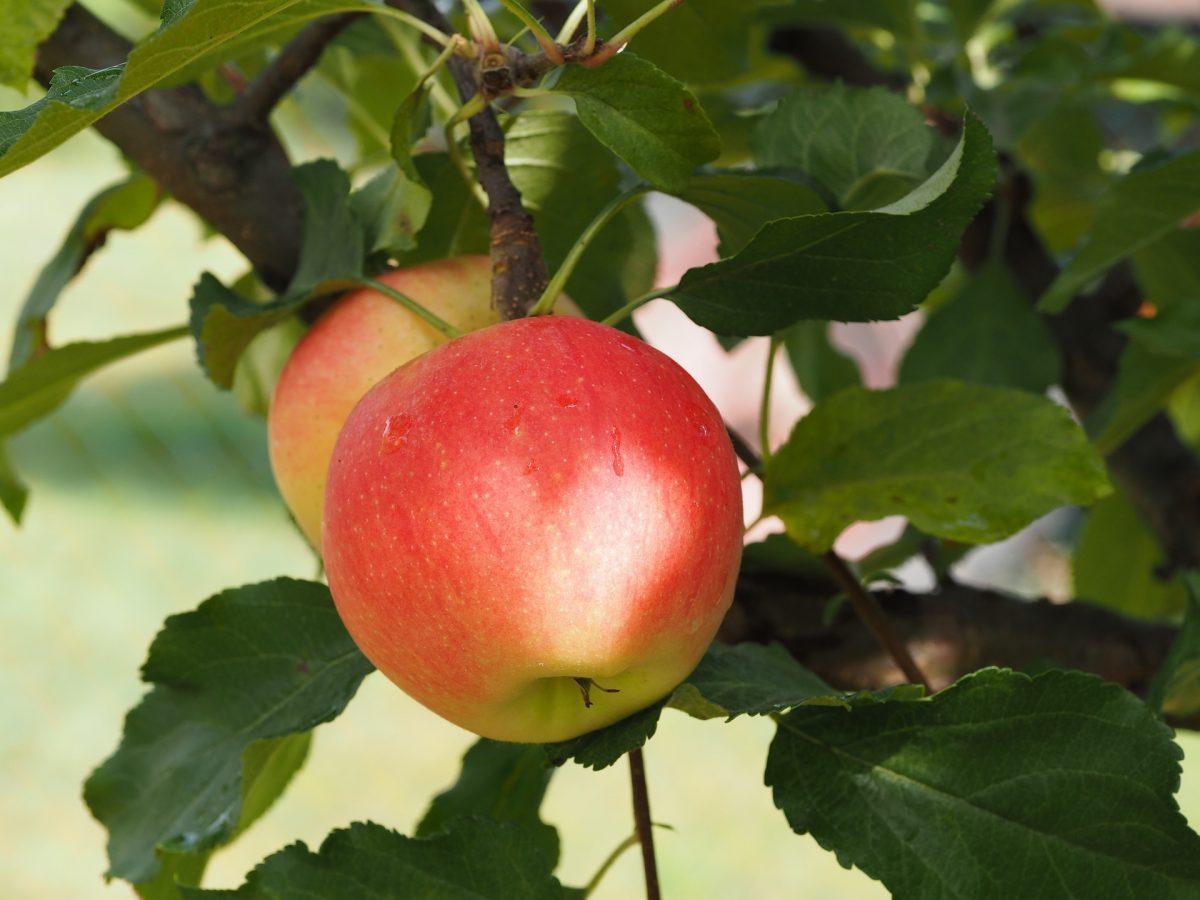Does eating an apple every day really keep the doctor away? Apples are certainly popular—ranking among the top three fruits produced around the world. They are easy to store and transport, and as a result, are typically available year-round in the U.S. In this piece we’ll explore how apples may benefit health and the best types for baking versus munching straight off the core.
Source Of
- Fiber, insoluble and soluble
- Phytochemicals (quercetin, catechin, chlorogenic acid, anthocyanin)
- Vitamin C
One serving, or one medium apple, provides about 95 calories, 0 gram fat, 1 gram protein, 25 grams carbohydrate, 19 grams sugar (naturally occurring), and 3 grams fiber.
Apples and Health
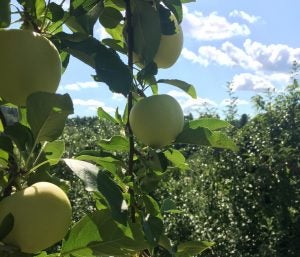
Apples are rich in quercetin and pectin, both of which are credited for supplying apples with their health benefits. [1] Quercetin is a flavonoid, a type of naturally occurring plant chemical that has antioxidant and anti-inflammatory effects. Pectin is a type of soluble fiber that may help prevent constipation and have a modest effect on lowering LDL, the “bad” cholesterol. Pectin is also fermented by beneficial bacteria in the colon, which produces short chain fatty acids that may play a role in the prevention of chronic diseases, including certain cancers and bowel disorders. [2,3]
Fresh, whole apples offer the most nutrients. Discarding the skin removes much of the fiber and the majority of flavonoids. Dehydrating or drying the apples removes vitamin C, which is predominantly in the flesh. In addition, sugar (along with extra calories) is often added to dried apples. Clear apple juice undergoes filtering and pasteurization, which removes most of the flavonoids and fibers. [3]
Overall research shows a benefit when adding apples to the diet. The studies below looked at the health effects of apples in the diet over time, or examined the effects of specific phytochemicals in apples.
Should I be concerned about pesticides?
However, the U.S. Department of Agriculture and the Environmental Protection Agency (EPA) have developed a national pesticide residue database called the Pesticide Data Program (PDP) to collect data each year on pesticide residues in food. One of the most common pesticides used on apples after harvest is diphenylamine, used to prevent apple scald or browning of the skin that can occur during storage. A 2016 analysis from the PDP found that 80% of 531 apple samples contained residues of this chemical at 0.002-3.8 ppm, which is below the EPA’s tolerance level of 10 ppm. [12] A tolerance level is the maximum amount of residue allowed on a raw food. This amount is based on a review of numerous scientific studies to determine possible harmful effects the chemical could have on humans, the amount of residue likely to remain in or on the food, and the amount of the food that people typically eat.
Although some pesticide residue can permeate into the flesh, washing and peeling the apple skin removes much of the pesticide. Apple skin supplies the majority of healthy phytochemicals and fiber, so it is not best to remove it. If one eats several apples a week and is unsure of the amount of pesticides used, purchasing organically grown apples may be an option, although direct evidence is not available that there is an important difference in health effects.
Some general tips for cleaning apples:
- The Food and Drug Administration recommends washing all produce thoroughly (including organic) under running water before preparing or eating. Firm produce like apples may be scrubbed with a clean produce brush. They do not recommend washing produce with soap, detergent, or even commercial produce washes. The washes are intended for killing bacteria rather than removing pesticides, and studies have shown that water is just as, if not more, effective than produce washes for removing bacteria. [13]
- Baking soda is effective at removing bacteria and breaking down pesticide residues so they are more easily rinsed off, but this method requires a few extra steps. Soak the apple in a baking soda solution of 1 teaspoon of baking soda and 2 cups water for 10-15 minutes, then rinse well. To save time, soak a large batch of apples, rinse well, and then dry each thoroughly with a towel before storing in the refrigerator (as any remaining excess moisture can promote mold or spoilage).
Keep in mind that the health benefits of eating fruits and vegetables outweigh potential pesticide risks, and should not deter one from including apples as part of a healthful diet.
Storage
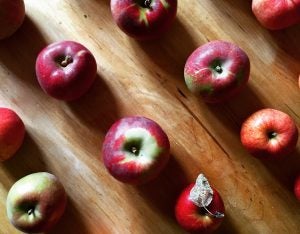 To prolong freshness, store in the refrigerator in the crisper drawer. They will usually remain fresh for at least 1-2 months, if not longer. Apples are a climacteric fruit, meaning that they continue to ripen after harvesting due to emitting a gas called ethylene. Cold temperatures slow down the production of ethylene. Even so, apples will still emit some ethylene when refrigerated and can speed the ripening of other produce stored nearby. Store apples in their own drawer apart from other produce to prevent this from happening.
To prolong freshness, store in the refrigerator in the crisper drawer. They will usually remain fresh for at least 1-2 months, if not longer. Apples are a climacteric fruit, meaning that they continue to ripen after harvesting due to emitting a gas called ethylene. Cold temperatures slow down the production of ethylene. Even so, apples will still emit some ethylene when refrigerated and can speed the ripening of other produce stored nearby. Store apples in their own drawer apart from other produce to prevent this from happening.- If stored at room temperature, the enzymes and ethylene gas in apples quicken ripening. They will last on your counter for about 1-2 weeks but the texture can change during this time.
Serve
There are at least a dozen types of apples found in U.S. supermarkets, but up to 100 varieties are available. Check out local farms and farmers markets for more unusual heirloom varieties. Some are best for cooking and baking, and others are enjoyed raw for snacking. They range from sweet to tart, and may produce a hearty crunch or a light crispy bite.
- Tart, mildly sweet apples with firm crisp flesh that don’t become mushy at high temperatures are best for baking: Jonagolds, Granny Smith, Honeycrisp, Melrose, Cortland, Braeburn.
- Juicy and sweet flavors are often chosen for eating: Gala, Red and Golden Delicious, Fuji, McIntosh. If you prefer tart over sweet, baking apples can certainly be eaten as well!
- Some fun ways to enjoy apples:
- Cut one apple into thin slices and spread with nut or seed butter.
- Enjoy a sweet/salty, crunchy/creamy combo by pairing apple slices with thin slices of cheddar cheese.
- Apple sandwich: Remove the center and seeds of an apple with a corer and slice the apple into rounds about a ½-inch thick. Spread one apple slice with nut or seed butter and sprinkle with granola or trail mix. Then place another apple slice on top.
- Oven-baked apple chips: Core apple and slice very thinly or with a mandoline. Place on a lightly greased baking sheet or parchment paper. Sprinkle with cinnamon. Bake at 225 degrees F for one hour (higher temperatures can burn the apples). Flip apple slices and bake for up to 1 hour more or until apple chips feel dry. Transfer to a cooling rack and let cool completely.
- Waldorf salad: Chop 2 large apples into small chunks and add to large bowl with ½ cup walnuts, 1 sliced celery rib, and ¼ cup raisins. Sprinkle with lemon juice. Prepare the dressing by combining ½ cup nonfat plain yogurt, 1-2 tablespoons mayonnaise, teaspoon of lemon zest, and pinch of pepper. Fold dressing into apple mixture and stir well.
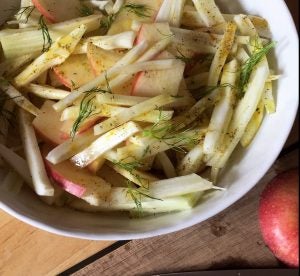 Apple, fennel, and endive salad: Thinly slice 2 large apples, 1 bulb of fennel, and 3 small endives. Squeeze over half of a lemon and add white balsamic vinegar, olive oil, salt and pepper to taste. Add chopped pecans for an additional crunch.
Apple, fennel, and endive salad: Thinly slice 2 large apples, 1 bulb of fennel, and 3 small endives. Squeeze over half of a lemon and add white balsamic vinegar, olive oil, salt and pepper to taste. Add chopped pecans for an additional crunch.
More recipes featuring apples:
Did You Know?
Apple juice and apple cider are different!
- Cider is produced when raw apples are mashed and pressed to extract the liquid. It is not filtered and sold either pasteurized or unpasteurized. This causes cider to appear cloudy, as it contains pulp and sediment. It is more acidic and contains more flavonoids than apple juice.
- Apple juice has been filtered to remove solids and pasteurized so that it remains fresher longer. Sugar is sometimes added. During filtration, the tart and bitter flavors from the natural apple flavonoids may be removed, so apple juice typically has a uniform sweet flavor.
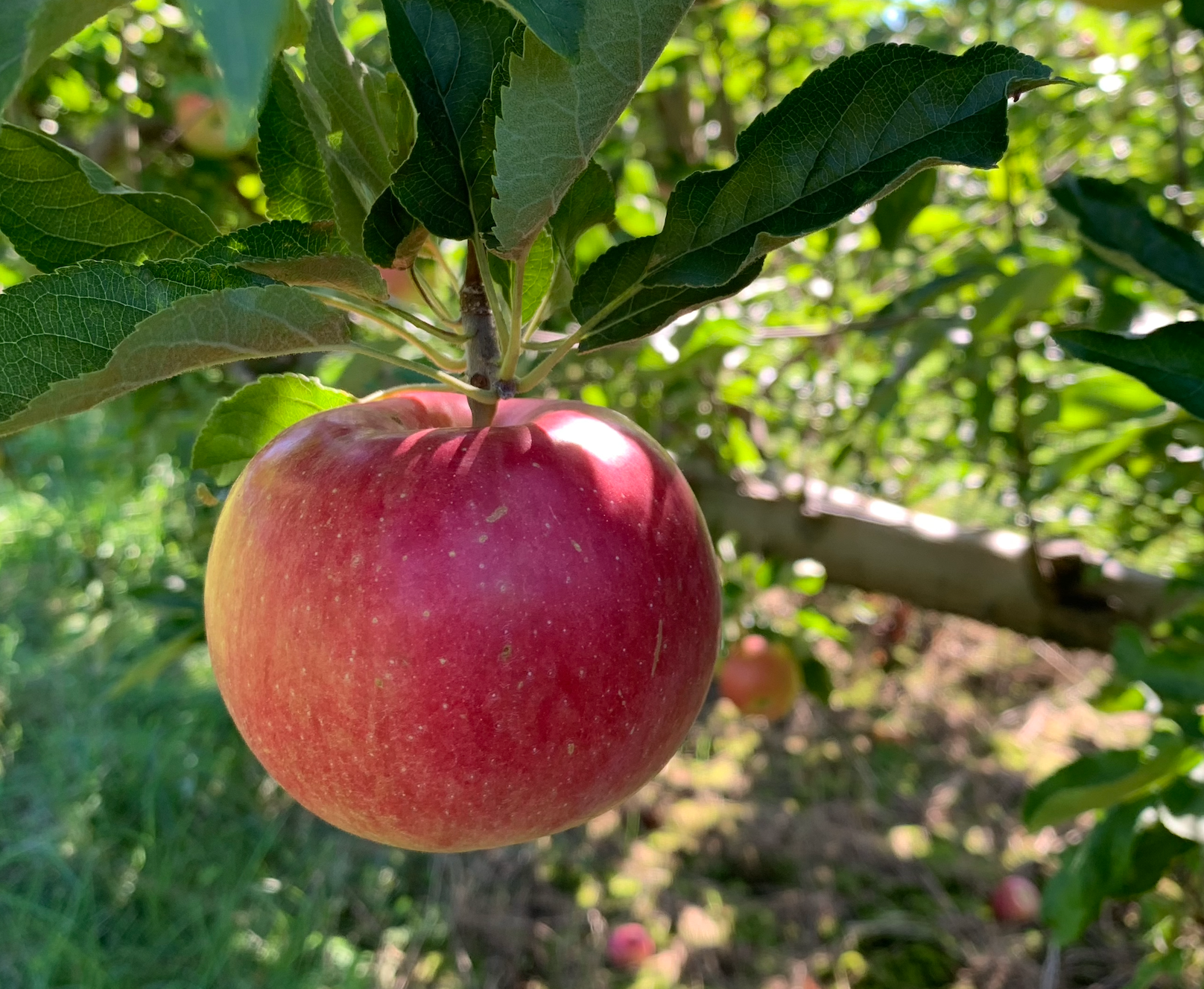
How do apples get their shape?
Terms of Use
The contents of this website are for educational purposes and are not intended to offer personal medical advice. You should seek the advice of your physician or other qualified health provider with any questions you may have regarding a medical condition. Never disregard professional medical advice or delay in seeking it because of something you have read on this website. The Nutrition Source does not recommend or endorse any products.
